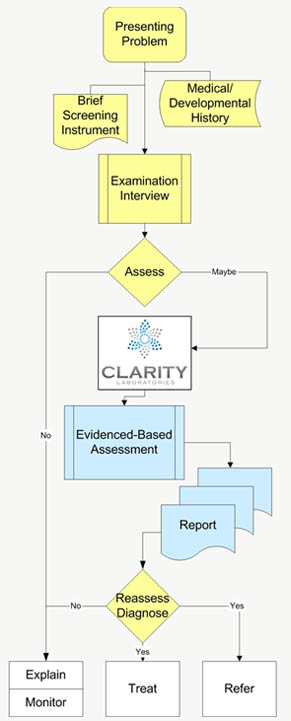Diagnostic Heuristics
Heuristics examine the process of discovery and the use of problem-solving procedures. For mental health assessments, improved heuristics seek to maximize the use of available resources and reduce the amount of error inherent in the diagnostic process.
A mental health assessment is a creative problem-solving task. Arriving at a diagnosis is more than formal deduction or the application of formulaic steps. The quantitative and qualitative data from objective and subjective sources are all considered by the primary care physician. This process reflects the "art" of diagnosis.
Improved Heuristics
Standard Practice
In many primary care settings, a mental health assessment involves four sources of data. The patient (or parent of the patient) typically arrives with a presenting problem to begin the diagnostic process. A clinical interview is conducted to define the presenting problem. Information from direct examination and observation is combined with data from the medical record and oftentimes a symptom screening instrument. Several diagnoses may be considered before a determination is made. At the conclusion of the diagnostic process, sub-clinical results are explained or monitored over time. Treatment is recommended in some cases. In other cases, a referral is made to a specialist for treatment or further assessment.
While the accompanying diagram suggests a linear, step-wise approach, the reality of the diagnostic process is a much more complex dialectic. The separate components interact and influence one another. The diagnostic steps often occur simultaneously and are interdependent. Contributing to the complexity, patients often arrive for the appointment with preconceived notions as to what is bothering them. They selectively volunteer symptoms that fit their conclusions. Symptoms that seem unrelated or would disconfirm the suspected problem may only be elicited through direct questioning. The primary care physician is not conducting the assessment within a vacuum. Knowledge of the patient's family, developmental and medical history inform the diagnostic process. This can lead to confirmatory bias channeling the breadth and depth of questioning and weighting of the relevance of the data.
Best Practice
Mental health assessments using Clarity Laboratories Reports improve diagnostic heuristics as illustrated in the diagram. Accessing evidence based assessment takes advantage of aspects of qualitative research that reduces sources of error and bias. The initial steps of mental health assessment within a primary care setting remain the same. However, prior to a decision, the primary care physician determines that additional data need to be collected. A referral to Clarity Laboratories initiates a process that adds new dimensions to the assessment process and can greatly improve diagnostic accuracy and treatment recommendations.
Advantages of Evidence Based Assessment
Clarity Laboratories conducts multi-informant assessments that broaden the data set under consideration. Collecting data across informants allows the observation of symptom expression across settings, time, and task demands. Similarities and differences that emerge in a multi-informant assessment improve confidence that what is being assessed is being measured. Multi-informant assessment increases the number of perspectives under consideration and reduces reliance on the patient as the sole source of information.
The use of the ASEBA questionnaires provides a broad scope of symptoms under consideration. Given the multi-determinant nature of the expression of mental health problems, a broad survey of symptoms considers alternative explanations for the presenting problem.
The prevalence of "co-morbid" conditions are more easily assessed using multi-informant assessment with a broad based assessment instrument. The increased awareness of other conditions allows for greater diagnostic accuracy and refinement of treatment recommendations.
Independent analysis of patient data unfiltered by subjective knowledge of the patient allows for more objective interpretation of the results. Clarity Laboratories Reports are reliant on the research data base to construct hypotheses and interpret results.
The determination to order a laboratory report creates a time barrier that imposes a re-examination of the decision making process at a later date. The time barrier reduces the urgency to respond immediately on the basis of incomplete information and moves the process away from "crisis management". The passage of time allows for a greater focus on long-standing traits with reduced emphasis on the current state. Consideration of the assessment results and recommendations of Clarity Laboratories Reports maintains an open diagnostic assessment process. The new information within the report forces re-examination of the initial formulation and allows the primary care physician to proceed with greater confidence.

